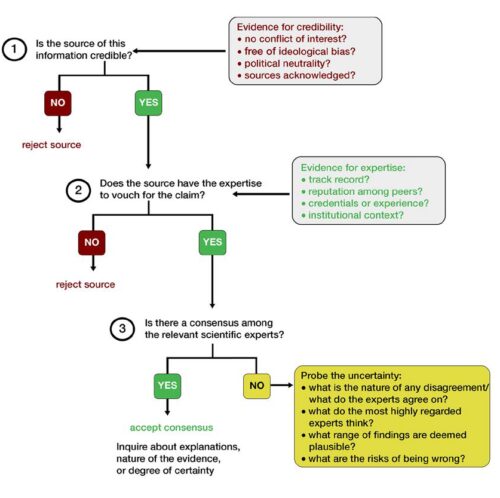Join Health Affairs for a virtual conversation between me and Angela Odoms-Young of Cornell University discussing the evolution of US food and nutrition policy, the current policy landscape, and thoughts on what lies ahead. It’s at 1:00 p.m. EDT. To join the Webinar, register here.
Teaching critical thinking about nutrition and health resources
A report, Science Education in an Age of Misinformation, from Stanford University and written by a distinguished group of scientists addresses a question I get asked all the time: how do you know whom to trust when reading articles about food and nutrition.
It presents a decision tree for evaluating information sources.
Although most of the report is focused on other science topics, it includes one nutrition example (Example 3, pages 34 and 35).
Example 3 presents two websites, one from the Partnership for a Healthier America, the other from ILSI, the International Life Sciences Institute.
The suggested lesson asks students to use the decision tree to evaluate the credibility of the information on the websites.
For this example,
if students search for ‘Partnership for a Healthier America,’ they will find that one of the first links to appear in the search results is from Wikipedia…they may decide to start with the Wikipedia page to get a broad sense of what other information is available about the organization. There students will read that PHA is a nonprofit organization focused on health and nutrition. Its president and CEO is Nancy Roman, who has years of experience working for world food programs, food banks, and nutrition non-profit organizations.
On the other hand, when students apply the same strategy to the ISLI web page, they are also likely to begin with the Wikipedia entry. This tells a very different story. While ISLI is also a nonprofit organization, the Wikipedia entry shows it was funded by a Coca-Cola executive and has numerous ties to food and chemical companies, such as McDonald’s and Pepsi. Such ties represent a clear conflict of interest and would strongly suggest that ISLI is not a credible source of information.
A good start? I think yes. Take a look and decide for yourself.
*******
For 30% off, go to www.ucpress.edu/9780520384156. Use code 21W2240 at checkout.



